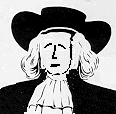Dissenters
Dissenters
Dissenters represented one of the two major challenges to the monopoly of the Church of England. Indeed, Presbyterians, Congregationalists and Baptists (not to mention Quakers) undoubtedly felt a strong sense of the unity of the “dissenting interest.”
After the passing of the ’Toleration Act’ in 1689, which brought to an end a period of persecution (1662-1687), and allowed Dissenters some freedom of worship, they became, on the whole, well tolerated throughout the century.
However, civil disabilities of the Test and Corporation Acts remained enforced, preventing Dissenters from holding public office, keeping them away from the army, and making it difficult for them to become barristers or physicians, which explains their involvement in trade and industry. Similarly, Dissenters were barred from the universities of Oxford and Cambridge, and therefore developed their own Academies.
Such disabilities could be alleviated by the practice of occasional conformity that has sometimes been blamed for the numerical decline of Dissenters after 1715 (from 5-10% of the overall population down to less than 4% in 1773).
The geographic distribution was uneven. Dissenters, 65% of whom lived in towns, were mostly represented in the South, the South West and the agricultural midlands.
Socially, Dissent appealed to the middle classes, though it also attracted members of the lower orders.
Politically, Dissenters supported the Hanoverian dynasty until the American revolution, when they voiced sympathy with the American cause, and with the French revolution.
On the whole, the “dissenting interest” probably exerted more political influence than numbers imply.
Presbyterianism
Presbyterianism is the form of church organisation in which elders, both lay people and ministers, govern. It was introduced to the British Isles by the leader of the Scottish Reformation, John Knox (c. 1514-72) whose theology was Calvinistic.
It is still widespread in Scotland, where the established Church of Scotland has been Presbyterian since the ’Glorious Revolution’ of 1688-9. Contrariwise, English Presbyterians have been regarded as non-conformists since the 1662 ’Act of Uniformity’, insofar as they do not conform to the rules of the Church of England. Like other Dissenters, they only enjoyed freedom of worship after the 1689 "Toleration Act.’
The name derives from the Greek word
![]() , which means ’elder’. Individual local congregations elect their own representatives or elders, including the minister, who together govern the church as a session or consistory. The ordained minister who is thus elected is, however, inducted and disciplined by the regional level of organisation, the presbytery, which administers groups of churches in one area. The national synod of the denomination is the General Assembly , in which equal numbers of ministers and lay elders represent presbyteries and consistories. The following diagram may thus briefly summarise the Presbyterian ecclesiastical hierarchy, in marked contrast with the episcopalian organisation of the Church of England, and the congregational self-government of Congregationalist, Baptist and Quaker communities:
, which means ’elder’. Individual local congregations elect their own representatives or elders, including the minister, who together govern the church as a session or consistory. The ordained minister who is thus elected is, however, inducted and disciplined by the regional level of organisation, the presbytery, which administers groups of churches in one area. The national synod of the denomination is the General Assembly , in which equal numbers of ministers and lay elders represent presbyteries and consistories. The following diagram may thus briefly summarise the Presbyterian ecclesiastical hierarchy, in marked contrast with the episcopalian organisation of the Church of England, and the congregational self-government of Congregationalist, Baptist and Quaker communities:
General Assembly (national)
![]()
![]()
Presbytery (provincial)
![]()
![]()
Session: ministers + elders (parochial)
![]()
elders
Congregationalism
Congregationalism is a form of church government based on the autonomy and independence of each congregation, in marked contrast with the ecclesiastical hierarchies of Presbyterianism and the Church of England. In seventeenth- and eighteenth- century England, congregationalists were known as Independents. They achieved political influence in the period following the seventeenth-century English civil wars. Like many other Dissenters, they suffered persecution and repression after the Restoration (1660), and enjoyed freedom of worship after the “Toleration Act” of 1689.
From a very early stage in their history, some of these puritans emigrated to America, where they established quasi theocratic colonies, like the Plymouth colony founded by the Pilgrim fathers (1620). They played a very influential part in shaping the political and religious values of New England, at least until the “American revolution” of 1776.
Quakers

- Quakers
The Society of Friends, commonly called Quakers, originated in seventeenth-century England under George Fox (1624-91) and expanded during the Puritan Commonwealth (1649-60). They hold that all believers equally receive divine guidance from an inward light, without any human mediation.
They therefore challenge the need for any form of ecclesiastical or social hierarchy. That explains the lack of ordained or educated ministry among them. Besides, early Quakers defied the social hierarchy by refusing to bow to a superior. They would not greet anybody but God by taking their hats off. Hence the commonplace image -or caricature- of the hat-wearing Quaker wearing puritanically dark clothes, unadorned by any ornament that might convey social distinction.
Friends even go so far as to question the power of language, rhetoric and music. They will therefore meet for silent worship, often sitting in a circle symbolising the equality of all believers, and waiting on the inward presence of the Spirit. Sometimes, though not necessarily every time, the silence may be momentarily interrupted by a Friend’s testimony.
The Quakers’ approach was so radical that they were the most persecuted and the least tolerated denomination among Dissenters, not only after the Restoration of the monarchy in 1660, but even after the ’Glorious Revolution’ and the ’Act of Toleration’ of 1689. In particular, their pacifism was resented by the population and there were outbreaks of anti-Quaker riots in times of war.
William Penn therefore founded a refuge for Quakers in colonial America and a “holy experiment” in religious toleration in what is now known as the state of Pennsylvania.

